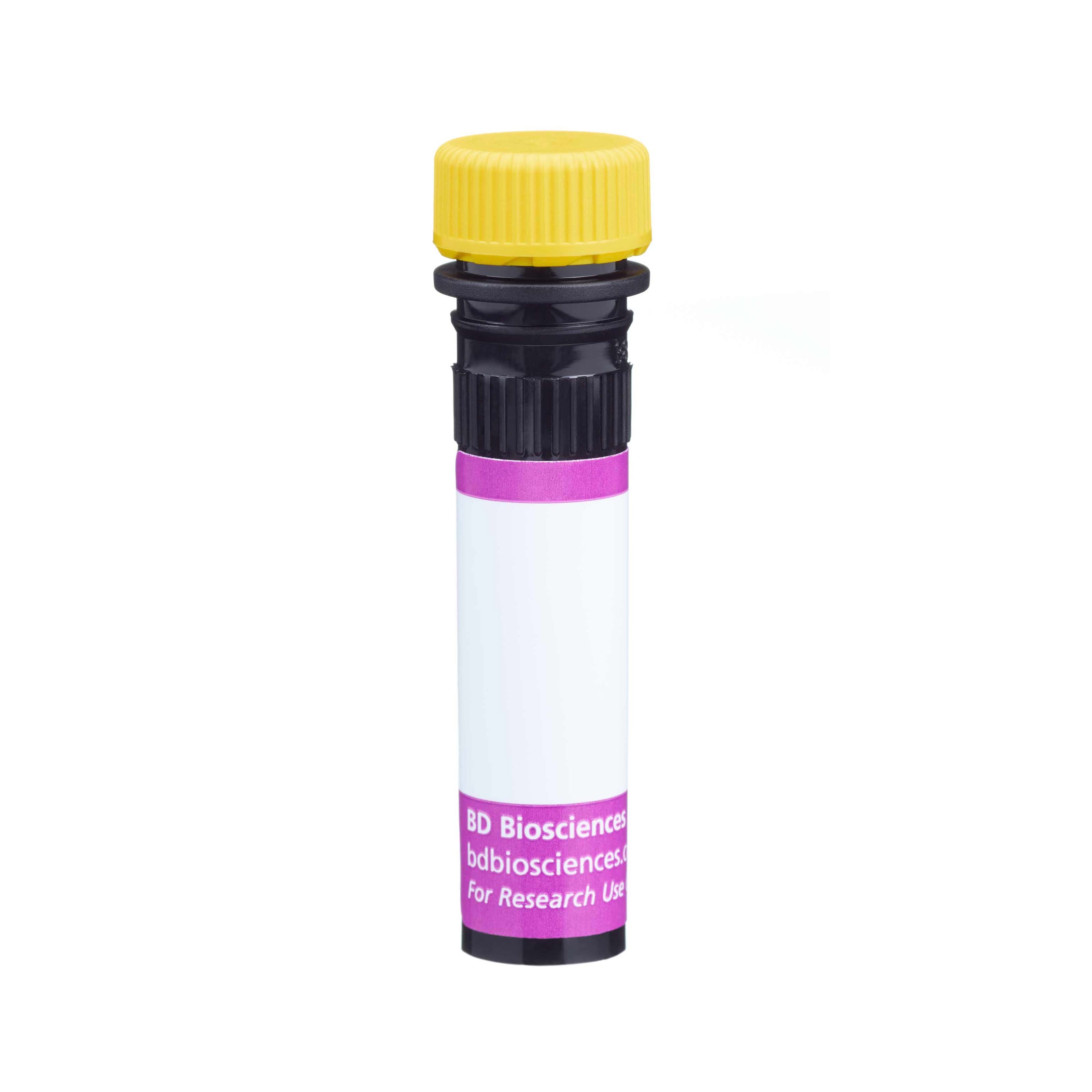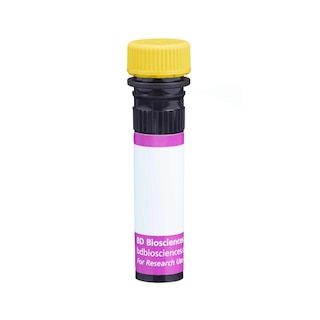Old Browser
This page has been recently translated and is available in French now.
Looks like you're visiting us from {countryName}.
Would you like to stay on the current country site or be switched to your country?




Flow cytometric analysis of CD273 expression on CD273-transfected Jurkat cells. Human MIT90 cells (CD273-transfected Jurkat cells) were stained with either BD Horizon™ BV650 Mouse IgG1, κ Isotype Control (Cat. No. 563231; dashed line histogram) or BD Horizon™ BV650 Mouse Anti-Human CD273 antibody (Cat. No. 563844; solid line histogram). Fluorescence histograms showing the expression of CD273 (or Ig Isotype control staining) were derived from events with the forward and side light-scatter characteristics of viable cells. Flow cytometric analysis was performed using a BD™ LSR II Flow Cytometer System.


BD Horizon™ BV650 Mouse Anti-Human CD273

Regulatory Status Legend
Any use of products other than the permitted use without the express written authorization of Becton, Dickinson and Company is strictly prohibited.
Preparation And Storage
Product Notices
- This reagent has been pre-diluted for use at the recommended Volume per Test. We typically use 1 × 10^6 cells in a 100-µl experimental sample (a test).
- An isotype control should be used at the same concentration as the antibody of interest.
- Caution: Sodium azide yields highly toxic hydrazoic acid under acidic conditions. Dilute azide compounds in running water before discarding to avoid accumulation of potentially explosive deposits in plumbing.
- Source of all serum proteins is from USDA inspected abattoirs located in the United States.
- Alexa Fluor® is a registered trademark of Molecular Probes, Inc., Eugene, OR.
- Brilliant Violet™ 650 is a trademark of Sirigen.
- For fluorochrome spectra and suitable instrument settings, please refer to our Multicolor Flow Cytometry web page at www.bdbiosciences.com/colors.
- Please refer to www.bdbiosciences.com/us/s/resources for technical protocols.
Companion Products


The MIH18 monoclonal antibody specifically binds to CD273 which is also known as the Programmed Death Ligand 2 (PD-L2) and B7-DC. CD273 is a type 1 transmembrane glycoprotein member of the B7 family and Ig superfamily. CD273 serves as a ligand for CD279, the Programmed Death 1 (PD-1) receptor. CD273 is expressed by dendritic cells, activated monocytes, medullary thymic epithelial cells, placental trophoblasts, and myocardial endothelium. CD273 can function as a coinhibitor of T cell functions by acting through CD279. Monoclonal antibodies that block the CD273 and CD279 interaction result in enhanced T cell proliferation and cytokine production. Thus, CD273 can play an important role in regulating T cell responses. Clone MIH18 is reportedly a blocking antibody.
The antibody was conjugated to BD Horizon™ BV650 which is part of the BD Horizon™ Brilliant Violet™ family of dyes. This dye is a tandem fluorochrome of BD Horizon™ BV421 with an Ex Max of 405-nm and an acceptor dye with an Em Max at 650-nm. BD Horizon™ BV650 can be excited by the violet laser and detected in a filter used to detect APC-like dyes (eg, 660/20-nm filter). Due to the excitation and emission characteristics of the acceptor dye, there will be spillover into the APC and Alexa Fluor® 700 detectors. However, the spillover can be corrected through compensation as with any other dye combination.

Development References (8)
-
Brown JA, Dorfman DM, Ma FR, et al. Blockade of programmed death-1 ligand on dendritic cells enhances T cell activation and cytokine production. J Immunol. 2003; 170:1257-1266. (Biology). View Reference
-
Carreno BM, Bennett F, Chau TA, et al. CTLA-4 (CD152) can inhibit T cell activation by two different mechanisms depending on its level of cell surface expression.. J Immunol. 2000; 165(3):1352-6. (Biology). View Reference
-
Carter L, Fouser LA, Jussif J, et al. PD-1:PD-L inhibitory pathway affects both CD4(+) and CD8(+) T cells and is overcome by IL-2. Eur J Immunol. 2002; 32:634-643. (Biology). View Reference
-
Latchman Y, Wood CR, Chernova T, et al. PD-L2 is a second ligand for PD-1 and inhibits T cell activation. Nat Immunol. 2001; 2(3):261-268. (Biology). View Reference
-
Ohigashi Y, Sho M, Yamada Y, et al. Clinical significance of programmed death-1 ligand-1 and programmed death-1 ligand-2 expression in human esophageal cancer. Clin Cancer Res. 2005; 11:2947-2953. (Clone-specific: Immunohistochemistry). View Reference
-
Pfistershammer K, Klauser C, Pickl WF, et al. No evidence for dualism in function and receptors: PD-L2/B7-DC is an inhibitory regulator of human T cell activation. Eur J Immunol. 2006; 36(5):1104-1113. (Clone-specific: Blocking, Flow cytometry, Functional assay). View Reference
-
Youngnak P, Kozono Y, Kozono H, et al. Differential binding properties of B7-H1 and B7-DC to programmed death-1. Biochem Biophys Res Commun. 2003; 307(3):672-677. (Biology). View Reference
-
Youngnak-Piboonratanakit P, Tsushima F, Otsuki N, et al. The expression of B7-H1 on keratinocytes in chronic inflammatory mucocutaneous disease and its regulatory role. Immunol Lett. 2004; 94(3):215-222. (Immunogen: Blocking, Flow cytometry, Fluorescence microscopy, Immunofluorescence, Immunohistochemistry). View Reference
Please refer to Support Documents for Quality Certificates
Global - Refer to manufacturer's instructions for use and related User Manuals and Technical data sheets before using this products as described
Comparisons, where applicable, are made against older BD Technology, manual methods or are general performance claims. Comparisons are not made against non-BD technologies, unless otherwise noted.
For Research Use Only. Not for use in diagnostic or therapeutic procedures.
Report a Site Issue
This form is intended to help us improve our website experience. For other support, please visit our Contact Us page.